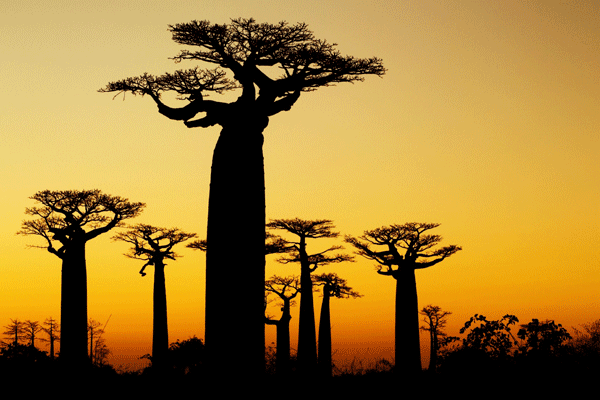Madagascar is quickly crawling up explorers’ to-go lists, as this island builds a repertoire as a one-of-a-kind destination with such incredible biodiversity that it is hardly believable that it all exists on one patch of land. It is rather a large patch of land at that! “The Great Red Island”, “The Eighth Continent” – Madagascar lies 400km off the east coast of Africa, divided from the motherland by the great Mozambique Channel. This is the 4th largest island in the world and upon it exists an entirely unique combination of habitats, wildlife, landscapes, mountains, rainforests and tropical beaches.
Almost all of the forest flora that exists here is endemic, while roughly 80% of the animal species can be found nowhere else on Earth. Out of all the magnificent bird species that occupy the skies, half of them are unique to Madagascar. This is the original island of spices, with an abundance of fragrant trees spilling aromas of vanilla and cinnamon into the air. Around 1000 species of orchid exist in Madagascar; lizards and geckos expertly camouflaged ; chameleons ranging from the size of a fingernail to that of a forearm; and insects whose body armour could originate in Jurassic Park. National Parks are a celebration of the Madagascan Mascot – the Lemur. From the world’s smallest primate, the 25g pygmy mouse lemur, to the 9kg indri, whose eerie calls echo through dense forest, bringing the sounds of the whales to Earth.
It is most rational to divide this extravagant blend of the world’s most desired natural environments according to a compass. Each co-ordinate brings with it a different terrestrial indulgence of woodland, ancient geology, tropical greenery, and sandy shorelines. An outstanding island boasting a broad variety of entirely natural attractions and cultural well-being – much of it remaining undiscovered. Here is to the mysterious Madagascar; a brief outline of what you will find and where to find it.

The Northern Tropics. This is probably the most recognised holiday destination in Madagascar and what it offers is truly what is sought after by beach bums and lovers of island life. The archipelago of Nosy Be is the picture of paradise; stretches of white sand nurtured by the persistent lapping of the warm waters of the Indian Ocean. Sun-bathers, snorkelers and scuba divers will discover the cherished quality of the North’s Nosy Be, while land lizards can retreat to the mainland and uncover the deep crater lakes dipping into the volcanic earth, and an isolated growth of montane forest in Montagne d-Ambre National Park. From palm-tree umbrellas on the luminescent, white sand to the most scenic of hiking trails leading wanderers through a world of waterfalls, upwards to the island’s highest peak, Tsaratanana Massif.
The great stretch along the east coast of Madagascar is renowned rainforest territory. A belt of greenery, an area of almost constant rainfall, of the intricate waterways of Canal Des Pangalanes – awaiting the exploration of curious boatmen and paddlers. Exotic fruits grow in abundance, while the fragrant air tantalises with the scents of spices growing along the water’s edge. Andasibe National Park is the protected home of the largest of the lemur species, the indri. Although boldly black and white in colour, hikers will hear their wailing calls before spotting them clinging to the trees. From the deepest, most unknown areas of tropical rainforest to a whale-watching paradise; Madagascar’s east coast boasts an abundance of qualities. The island of Saint Marie is located but a boat-ride away from the mainland, a journey across a channel that becomes the migration route for hundreds of breeding humpback whales, as they make a grateful escape from the Antarctic waters. Ile Sainte Marie is also the beholder of ancient history, evidence of which can be explored in the island’s eerie cemetery, which remains untouched graveyard for pirates, equipped with cross-bones, as if for characterful effect.

The south of Madagascar represents the metamorphosis of the nourished east to the thirsty west, while introducing its own element of uniqueness. Spiny forests of the south appear almost as relatives to the baobab – also a common resident of this majestic land. These trees salute the sun, with their route-like branches extending outwards rather than upwards, creating a silhouette against the dusk skies burnt orange by the late sun. The south is a masterpiece of splendour and is known as the wildest and driest of all the Madagascan regions. Investigative eyes may uncover the shell evidence of the extinct elephant bird whilst journeying on foot through the staggering canyons of Isalo National Park. In Fort Dauphin, it is recommended that one indulges in the edible speciality of the island – lobster. Here it is served in rich abundance, tantalising the taste buds of diners and expertly concluding a seaside soiree.
Completing the geographical circle of coastal Madagascar is the Wild West. This is an area of vast sandy beaches and deciduous forests – trees that ripen with the season and relinquish their leaves at the end, revealing bare branches. As if in opposition with the frequented forested region of the east, western Madagascar is remote and sacred. Prehistoric rock formations seek the skies in jagged limestone peaks, interspersed with lower lying vegetation. The Tsingy de Bemaraha Reserve is a World Heritage Site, praised for its unusual rockery and the caves hidden within. This is a difficult destination to reach, but the rewards sought of utter wilderness are more than worth the effort.
Chloe Cooper





